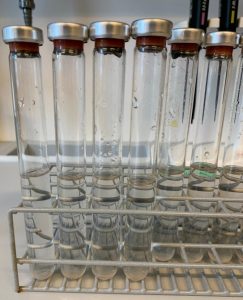Hello, welcome to my first blog!
My name is Ramsha Iqbal, and I am in the second year of my master’s in microbiology. I am very glad to be part of this field. Since I was in school, I have been curious about microbes. I decided to participate in the field of microbiology, but my background was not strong in it. I decided to do some research in it, and I got course Bio299. I found a project to investigate new species in Desulfovibrio. My project is to investigate the characterization of an anaerobic strain from genera Desulfobirio which was isolated from the Ægir vent field.

Figure 3: Spectrophotometer to measure growth by light absorbance. Used for samples of selected temperature scales.
Isolation of new microbial strains (anaerobic or aerobic) and identification of their function and application can be helpful in human welfare. Besides considering microbes as disease causing agents, microorganisms have made significant progress to understand the important functions they play in agriculture and food. So, researchers try to take advantage of microbial processes to create useful products, produce energy and clean the environment.
I used a spectrophotometer to collect measurements of the growth in the samples tubes which were set for selected temperature scale. After collecting measurements, I took the average of all measurements on each selected temperature. I plotted the growth curves based on collected data on Microsoft Excel. Growth was also investigated with 0-4% concentration of NaCl and examined the samples under microscope. I also performed sequence analysis.
The laboratory work of research part was time consuming. Before collecting data for both parameters, first anerobic media was prepared which took a lot of time, then sample and substrate used for this experiment were injected in prepared anerobic media. After that samples were kept under incubation for more than one week or until microbes have been grown. For sequence analysis, we sent the PCR products to the sequence lab, and it took two weeks. But during all this period, including failing in some laboratory tasks, I learned a lot.
It was an interesting experience to be part of this research project. It will also be helpful for my master’s thesis. It gave me the capability to think broadly about microbes. I will strongly recommend other students to choose this course and gain exciting experience in the research. This course will also be helpful for those students who do not have any idea what to select in their master’s thesis. It will help to interact with different people who can help to give suggestion or offer something awesome for research.


